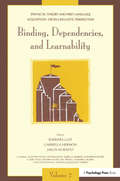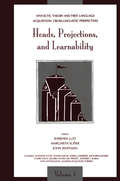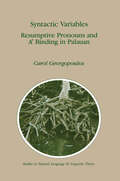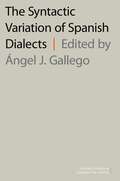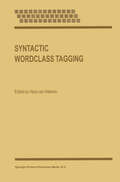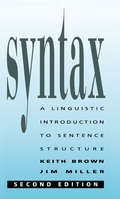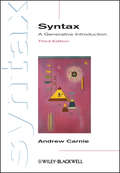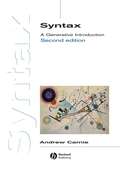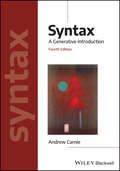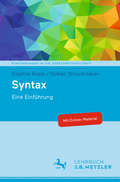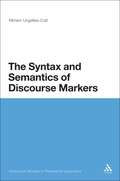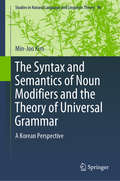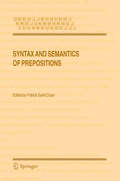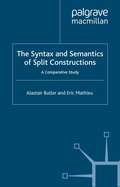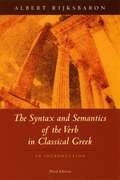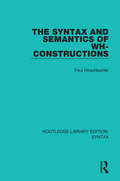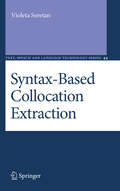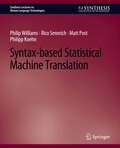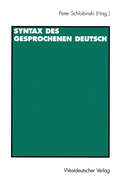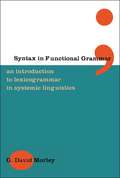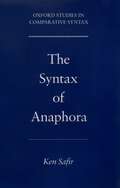- Table View
- List View
Syntactic Theory and First Language Acquisition: Cross-linguistic Perspectives -- Volume 1: Heads, Projections, and Learnability -- Volume 2: Binding, Dependencies, and Learnability
by Vol. 1 Barbara Lust Margarita Su¤er John Whitman Vol. 2 Barbara Lust Gabriella HermonUniversal Grammar (UG) is a theory of both the fundamental principles for all possible languages and the language faculty in the "initial state" of the human organism. These two volumes approach the study of UG by joint, tightly linked studies of both linguistic theory and human competence for language acquisition. In particular, the volumes collect comparable studies across a number of different languages, carefully analyzed by a wide range of international scholars. The issues surrounding cross-linguistic variation in "Heads, Projections, and Learnability" (Volume 1) and in "Binding, Dependencies, and Learnability" (Volume 2) are arguably the most fundamental in UG. How can principles of grammar be learned by general learning theory? What is biologically programmed in the human species in order to guarantee their learnability? What is the true linguistic representation for these areas of language knowledge? What universals exist across languages? The two volumes summarize the most critical current proposals in each area, and offer both theoretical and empirical evidence bearing on them. Research on first language acquisition and formal learnability theory is placed at the center of debates relative to linguistic theory in each area. The convergence of research across several different disciplines -- linguistics, developmental psychology, and computer science -- represented in these volumes provides a paradigm example of cognitive science.
Syntactic Theory and First Language Acquisition: Cross-linguistic Perspectives -- Volume 1: Heads, Projections, and Learnability -- Volume 2: Binding, Dependencies, and Learnability
by Vol. 1 Barbara Lust Margarita Su¤er John Whitman Vol. 2 Barbara Lust Gabriella HermonUniversal Grammar (UG) is a theory of both the fundamental principles for all possible languages and the language faculty in the "initial state" of the human organism. These two volumes approach the study of UG by joint, tightly linked studies of both linguistic theory and human competence for language acquisition. In particular, the volumes collect comparable studies across a number of different languages, carefully analyzed by a wide range of international scholars. The issues surrounding cross-linguistic variation in "Heads, Projections, and Learnability" (Volume 1) and in "Binding, Dependencies, and Learnability" (Volume 2) are arguably the most fundamental in UG. How can principles of grammar be learned by general learning theory? What is biologically programmed in the human species in order to guarantee their learnability? What is the true linguistic representation for these areas of language knowledge? What universals exist across languages? The two volumes summarize the most critical current proposals in each area, and offer both theoretical and empirical evidence bearing on them. Research on first language acquisition and formal learnability theory is placed at the center of debates relative to linguistic theory in each area. The convergence of research across several different disciplines -- linguistics, developmental psychology, and computer science -- represented in these volumes provides a paradigm example of cognitive science.
Syntactic Variables: Resumptive Pronouns and A′ Binding in Palauan (Studies in Natural Language and Linguistic Theory #24)
by C. GeorgopoulosThis book represents the culmination of an extended period of field work on the Palauan language, carried out while I was a graduate student at the University of California at San Diego. The book was born as a short term paper written in 1982; from a forgettable infancy, that paper grew and grew, reaching the age of majority in my dissertation at the end of 1985. Some of its offspring have gone off on their own, as indepen dent papers, as course materials, or as thoughts that have not yet com pletely materialized. Some have been disowned. The full adulthood of this study of Palauan is realized in the present book. Virtually every section of the dissertation has been rewritten, updated, or otherwise (I hope) improved. Where the dissertation was still struggling with various problems, the book has found solutions. The aim of the book remains, however, to give broad coverage of Palauan, with emphasis on A' binding, rather than to focus narrowly on a few highly specific theoretical issues. I hope to have achieved a balance between presenting the language clearly and nonprejudicially, and deal ing with various of its properties in current theoretical terms. If I have, the book should prove to be a resource for further typological study of the phenomena it describes.
The Syntactic Variation of Spanish Dialects (Oxford Studies in Comparative Syntax)
This book offers a comprehensive overview of the syntactic variation of the dialects of Spanish. More precisely, it covers Spanish theoretical syntax that takes as its data source non-standard grammatical phenomena. Approaching the syntactic variation of Spanish dialects opens a door not only to the intricacies of the language, but also to a set of challenges of linguistic theory itself, including language variation, language contact, bilingualism, and diglossia. The volume is divided into two main sections, the first focusing on Iberian Spanish and the second on Latin American Spanish. Chapters cover a wide range of syntactic constructions and phenomena, such as clitics, agreement, subordination, differential object marking, expletives, predication, doubling, word order, and subjects. This volume constitutes a milestone in the study of syntactic variation, setting the stage for future work not only in vernacular Spanish, but all languages.
Syntactic Wordclass Tagging (Text, Speech and Language Technology #9)
by H. Van HalterenIn both the linguistic and the language engineering community, the creation and use of annotated text collections (or annotated corpora) is currently a hot topic. Annotated texts are of interest for research as well as for the development of natural language pro cessing (NLP) applications. Unfortunately, the annotation of text material, especially more interesting linguistic annotation, is as yet a difficult task and can entail a substan tial amount of human involvement. Allover the world, work is being done to replace as much as possible of this human effort by computer processing. At the frontier of what can already be done (mostly) automatically we find syntactic wordclass tagging, the annotation of the individual words in a text with an indication of their morpho syntactic classification. This book describes the state of the art in syntactic wordclass tagging. As an attempt to give an overall view of the field, this book is of interest to (at least) two, possibly very different, types of reader. The first type consists of those people who are using, or are planning to use, tagged material and taggers. They will want to know what the possibilities and impossibilities of tagging are, but are not necessarily interested in the internal working of automatic taggers. This, on the other hand, is the main interest of our second type of reader, the builders of automatic taggers and other natural language processing software.
Syntax: A Linguistic Introduction to Sentence Structure
by Keith Brown Jim MillerThe second edition of this invaluable introductory text takes account of developments in syntactic studies. Dealing with the whole range of syntax, this book explains, in a lucid and approachable way, why linguists have adopted certain solutions to problems and not others. This book introduces the basic concepts used in the description of syntax, independently of any single model of grammar. Profusely illustrated with diagrams, there are sets of exercises for every chapter which can be used in class or by students working independently.
Syntax: A Linguistic Introduction to Sentence Structure
by Keith Brown Jim MillerThe second edition of this invaluable introductory text takes account of developments in syntactic studies. Dealing with the whole range of syntax, this book explains, in a lucid and approachable way, why linguists have adopted certain solutions to problems and not others. This book introduces the basic concepts used in the description of syntax, independently of any single model of grammar. Profusely illustrated with diagrams, there are sets of exercises for every chapter which can be used in class or by students working independently.
Syntax: A Generative Introduction (Introducing Linguistics #18)
by Andrew CarnieAndrew Carnie’s bestselling textbook on syntax has guided thousands of students through the discipline of theoretical syntax; retaining its popularity due to its combination of straightforward language, comprehensive coverage, and numerous exercises. In this third edition, topics have been updated, new exercises added, and the online resources have been expanded. Supported by expanded online student and instructor resources, including extra chapters on HPSG, LFG and time-saving materials for lecturers, including problem sets, PowerPoint slides, and an instructors’ manual Features new chapters on ellipsis, auxiliaries, and non-configurational languages Covers topics including phrase structure, the lexicon, Case theory, movement, covert movement, locality conditions, VP shells, and control Accompanied by a new optional workbook, available separately, of sample problem sets which are designed to give students greater experience of analyzing syntactic structure
Syntax: A Generative Introduction (Introducing Linguistics #19)
by Andrew CarnieAndrew Carnie’s bestselling textbook on syntax has guided thousands of students through the discipline of theoretical syntax; retaining its popularity due to its combination of straightforward language, comprehensive coverage, and numerous exercises. In this third edition, topics have been updated, new exercises added, and the online resources have been expanded. Supported by expanded online student and instructor resources, including extra chapters on HPSG, LFG and time-saving materials for lecturers, including problem sets, PowerPoint slides, and an instructors’ manual Features new chapters on ellipsis, auxiliaries, and non-configurational languages Covers topics including phrase structure, the lexicon, Case theory, movement, covert movement, locality conditions, VP shells, and control Accompanied by a new optional workbook, available separately, of sample problem sets which are designed to give students greater experience of analyzing syntactic structure
Syntax: A Generative Introduction (Introducing Linguistics #23)
by Andrew CarnieBuilding on the success of the bestselling first edition, the second edition of this textbook provides a comprehensive and accessible introduction to the major issues in Principles and Parameters syntactic theory, including phrase structure, the lexicon, case theory, movement, and locality conditions. Includes new and extended problem sets in every chapter, all of which have been annotated for level and skill type Features three new chapters on advanced topics including vP shells, object shells, control, gapping and ellipsis and an additional chapter on advanced topics in binding Offers a brief survey of both Lexical-Functional Grammar and Head-Driven Phrase Structure Grammar Succeeds in strengthening the reader's foundational knowledge, and prepares them for more advanced study Supported by an instructor's manual and online resources for students and instructors, available at www.blackwellpublishing.com/carnie
Syntax: A Generative Introduction (Introducing Linguistics)
by Andrew CarnieThe extensively updated fourth edition of the leading introductory textbook on theoretical syntax, including an all-new chapter and additional problem sets Now in its fourth edition, Andrew Carnie's Syntax: A Generative Introduction remains the leading introduction to the rules, principles, and processes that determine the structure of sentences in language. Comprehensive yet accessible, the text provides a well-balanced, student-friendly introduction to syntactic theory. Topics include phrase structure, the lexicon, binding theory, case theory, movement, covert movement, locality conditions, ditransitives, verbal inflection and auxiliaries, ellipsis, control theory, non-configurational languages, and more. Students are provided with numerous exercises and pedagogical features designed to strengthen comprehension, review learning objectives, test knowledge, and highlight major issues in the field. The fourth edition features revised material throughout, including a new section on Chomsky's Merge and additional problem sets in every chapter, while new examples throughout the text broaden the appeal and relatability of the text to a more diverse set of students. The optional The Syntax Workbook: A Companion to Carnie's Syntax has also been thoroughly revised and expanded to offer students the opportunity to practice the skills and concepts introduced in the primary text. This classic textbook: Presents authoritative and comprehensive coverage of basic, intermediate, and advanced topics Includes ample exercises and clear explanations using straightforward language Offers extensive online student and instructor resources, including problem sets, PowerPoint slides, an updated instructor's manual, author-created videos, online-only chapters, and other supplementary material Features a wealth of learning tools, including learning objectives, discussion questions, and problems of varying levels of difficulty In the new fourth edition, Syntax: A Generative Introduction remains an essential textbook for beginning syntacticians, perfect for undergraduate and graduate course in linguistics, grammar, language, and second language teaching. Available as a set with The Syntax Workbook: A Companion to Carnie's Syntax, 2nd Edition
Syntax: A Generative Introduction (Introducing Linguistics #30)
by Andrew CarnieThe extensively updated fourth edition of the leading introductory textbook on theoretical syntax, including an all-new chapter and additional problem sets Now in its fourth edition, Andrew Carnie's Syntax: A Generative Introduction remains the leading introduction to the rules, principles, and processes that determine the structure of sentences in language. Comprehensive yet accessible, the text provides a well-balanced, student-friendly introduction to syntactic theory. Topics include phrase structure, the lexicon, binding theory, case theory, movement, covert movement, locality conditions, ditransitives, verbal inflection and auxiliaries, ellipsis, control theory, non-configurational languages, and more. Students are provided with numerous exercises and pedagogical features designed to strengthen comprehension, review learning objectives, test knowledge, and highlight major issues in the field. The fourth edition features revised material throughout, including a new section on Chomsky's Merge and additional problem sets in every chapter, while new examples throughout the text broaden the appeal and relatability of the text to a more diverse set of students. The optional The Syntax Workbook: A Companion to Carnie's Syntax has also been thoroughly revised and expanded to offer students the opportunity to practice the skills and concepts introduced in the primary text. This classic textbook: Presents authoritative and comprehensive coverage of basic, intermediate, and advanced topics Includes ample exercises and clear explanations using straightforward language Offers extensive online student and instructor resources, including problem sets, PowerPoint slides, an updated instructor's manual, author-created videos, online-only chapters, and other supplementary material Features a wealth of learning tools, including learning objectives, discussion questions, and problems of varying levels of difficulty In the new fourth edition, Syntax: A Generative Introduction remains an essential textbook for beginning syntacticians, perfect for undergraduate and graduate course in linguistics, grammar, language, and second language teaching. Available as a set with The Syntax Workbook: A Companion to Carnie's Syntax, 2nd Edition
Syntax: Eine Einführung (Einführungen in die Sprachwissenschaft)
by Sophie Repp Volker StruckmeierDieses Buch bietet eine Einführung in die generative Syntax, eines der verbreitetsten Syntaxmodelle. Es zeigt, wie sich Satzstrukturen aus Wortbestandteilen und Wörtern zusammensetzen, und beschreibt, wie wir mittels dieser Strukturen den Zusammenhang von Form und Bedeutung erklären können. Studierende lernen systematisch und sicher, syntaktische Analysen anzufertigen, und werden an das eigenständige Studium der Forschungsliteratur herangeführt. Das Buch zeigt auch, dass die generative Syntax – anders als traditionelle Grammatiken – Sprache als faszinierende kognitive Fähigkeit des Menschen beschreiben kann. Mit vielen Beispielen, Übungen und einem Sachregister deutscher und englischer Fachbegriffe.
The Syntax and Semantics of Discourse Markers (Continuum Studies in Theoretical Linguistics)
by Miriam Urgelles-CollExamining the syntax and semantics of discourse markers, this book employs a syntactic approach to describe discourse markers in Head-Driven Phrase Structure Grammar (HPSG), relevant in a theory of discourse because it provides a framework in which all levels of grammar can be integrated. Since discourse markers operate at discourse level, a well developed discourse theory is required - in this case, Segmented Discourse Representation Theory (SDRT) is adopted. During the course of the book, Minimal Recourse Semantics is explained as it provides an integration of HPSG and SDRT. The approach described is exemplified with an analysis of 'anyway'. This book provides a detailed overview of research on discourse markers covering different areas of linguistics: from a discourse analysis point of view, to a Relevance Theory perspective going through a computational linguistics approach. Containing a precise summary of HPSG and the recently developed SDRT, it will be of great interest to researchers in semantics, pragmatics, grammar and discourse analysis.
The Syntax and Semantics of Noun Modifiers and the Theory of Universal Grammar: A Korean Perspective (Studies in Natural Language and Linguistic Theory #96)
by Min-Joo KimThis book takes Korean as a basis to provide a detailed universal Determiner Phrase (DP) structure. Adnominal adjectival expressions are apparently optional noun dependents but their syntax and semantics have been shown to provide an important window on the internal structure of DP. By carefully examining data from Korean, an understudied language, as well as from other unrelated languages, the book provides a broad perspective on the phenomenon of noun modification and its cross-linguistic variations. Furthermore, it offers not only a thorough syntactic analysis but also a formal semantic analysis of noun modifiers that extends beyond a single language. This book will be of great interest to researchers interested in theoretical syntax, its interfaces with semantics, pragmatics, linguistic typology, and language variation.
Syntax and Semantics of Prepositions (Text, Speech and Language Technology #29)
by Patrick Saint-DizierThis is the first book to provide an integrated view of preposition from morphology to reasoning, via syntax and semantics. It offers new insights in applied and formal linguistics, and cognitive science. It underlines the importance of prepositions in a number of computational linguistics applications, such as information retrieval and machine translation. The book presents a wide range of views and applications to various linguistic frameworks.
The Syntax and Semantics of Split Constructions: A Comparative Study
by A. Butler E. MathieuSplit constructions are very widespread in natural languages. The separation of the semantic restriction of a quantifier from that quantifier is a typical example of such a construction. This study addresses the problem that such discontinuous strings exhibit a number of locality constraints, including intervention effects. These are shown to follow from the interaction of a minimalist syntax with a semantics that directly assigns a model-theoretic interpretation to syntactic logical forms. The approach is shown to have wide empirical coverage and a conceptual simplicity. The book will be of interest to scholars and advanced students of syntax and semantics.
The Syntax and Semantics of the Verb in Classical Greek: An Introduction: Third Edition
by Albert RijksbaronThe verb is, in any language, the motor of all communication: no verb, no action. In Greek, verb forms change not only with person, number, tense, and voice, but in four possible moods as well. Available now in a special reprint for the North American market, The Syntax and Semantics of the Verb in Classical Greek is an incomparable resource to students and scholars charged with the considerable task of untangling the Greek language’s many complexities. With clear, concise instruction, Albert Rijksbaron shows how the various verb forms contribute to the richness of the Greek literature as we know it, in this essential guide for both novices and experienced practitioners. “[This study] belongs in the library of any Hellenist and any linguist interested in ancient Greek.”—Classics Newsletter (Anzeiger für die Altertumswissenschaft) “Every use is described with concision and clarity.”—Kratylos “The book offers an example of how the empirical thoroughness of traditional Classical scholarship can be brought into contact with general linguistic theory.”—Language
The Syntax and Semantics of Wh-Constructions (Routledge Library Editions: Syntax)
by Paul HirschbuhlerThis title, first published in 1985, provides a detailed analysis of aspects of the semantics and the syntax of some wh-constructions. The first part of the book deals with the semantics of questions, whilst the other part discusses the syntax of que and quoi (what) in questions in French and the syntax of free relatives in French and other languages. This title will be of interest to students of language and linguistics.
The Syntax and Semantics of Wh-Constructions (Routledge Library Editions: Syntax)
by Paul HirschbuhlerThis title, first published in 1985, provides a detailed analysis of aspects of the semantics and the syntax of some wh-constructions. The first part of the book deals with the semantics of questions, whilst the other part discusses the syntax of que and quoi (what) in questions in French and the syntax of free relatives in French and other languages. This title will be of interest to students of language and linguistics.
Syntax-Based Collocation Extraction (Text, Speech and Language Technology #44)
by Violeta SeretanSyntax-Based Collocation Extraction is the first book to offer a comprehensive, up-to-date review of the theoretical and applied work on word collocations. Backed by solid theoretical results, the computational experiments described based on data in four languages provide support for the book’s basic argument for using syntax-driven extraction as an alternative to the current cooccurrence-based extraction techniques to efficiently extract collocational data. The work described in Syntax-Based Collocation Extraction focuses on using linguistic tools for corpus-based identification of collocations. It takes advantage of recent advances in parsing to propose a novel deep syntactic analytic collocation extraction that has applicability to a range of important core tasks in Computational Linguistics. The book is useful for anyone interested in computational analysis of texts, collocation phenomena, and multi-word expressions in general.
Syntax-based Statistical Machine Translation (Synthesis Lectures on Human Language Technologies)
by Philip Williams Rico Sennrich Matt PostThis unique book provides a comprehensive introduction to the most popular syntax-based statistical machine translation models, filling a gap in the current literature for researchers and developers in human language technologies. While phrase-based models have previously dominated the field, syntax-based approaches have proved a popular alternative, as they elegantly solve many of the shortcomings of phrase-based models. The heart of this book is a detailed introduction to decoding for syntax-based models. The book begins with an overview of synchronous-context free grammar (SCFG) and synchronous tree-substitution grammar (STSG) along with their associated statistical models. It also describes how three popular instantiations (Hiero, SAMT, and GHKM) are learned from parallel corpora. It introduces and details hypergraphs and associated general algorithms, as well as algorithms for decoding with both tree and string input. Special attention is given to efficiency, including search approximations such as beam search and cube pruning, data structures, and parsing algorithms. The book consistently highlights the strengths (and limitations) of syntax-based approaches, including their ability to generalize phrase-based translation units, their modeling of specific linguistic phenomena, and their function of structuring the search space.
Syntax des gesprochenen Deutsch
by Peter SchlobinskiDer Band enthält zehn Beiträge zur Syntax des gesprochenen Deutsch. Die Beiträge sind empirisch fundiert, wobei syntaktische Strukturen in Gesprächssequenzen qualitativ und/oder quantitativ analysiert werden. Folgende Aspekte sind Gegenstand der Analyse: Wort- und Satzgliedstellung, Ellipsen, Selbstreparaturen, Parataxe, direkte und indirekte Rede, syntaktische Variation und Syntaxfehler in der Lernervarietät Deutsch. Die Syntaxanalysen beziehen pragmatische Faktoren mit ein, so daß die Analysen im weitesten Sinne strukturfunktional sind.
Syntax in Functional Grammar: An Introduction to Lexicogrammar in Systemic Linguistics
by G. David MorleyThis well-illustrated book outlines a framework for the analysis of syntactic structure from a perspective of a systematic functional grammar. In oart, the book goes back to the grammar's "scale and category" roots, but now with the aim of presenting how a descriptive framework illustrating how the analysis of the syntactic structure can reflect the meaning structure.The contents are divided into four sections. Section one gives a brief overview of systematic grammar, including the linguistic system, context of situation, and language fractions. Developing the lexicogrammar, section two considers formal units and their classes, but the principal focus is on section three, which covers the role of units as elements of structure. Section four discusses areas of structural complexity and concludes with several refinements to the analysis format.
The Syntax of Anaphora (Oxford Studies in Comparative Syntax)
by Ken SafirIn this work, Ken Safir develops a comprehensive theory on the role of anaphora in syntax. First, he contends that the complementary distribution of forms that support the anaphoric readings is not accidental, contrary to most current thinking, but rather should be derived from a principle, one that he proposes in the form of an algorithm. Secondly, he maintains that dependent identity relations are always possible where they are not prohibited by a constraint. Lastly, he proposes that there are no parameters of anaphora - that all anaphora-specific principles are universal, and that the patterns of anaphora across languages arise entirely from a restricted set of lexical properties. This comprehensive consideration of anaphora redirects current thinking on the subject.
